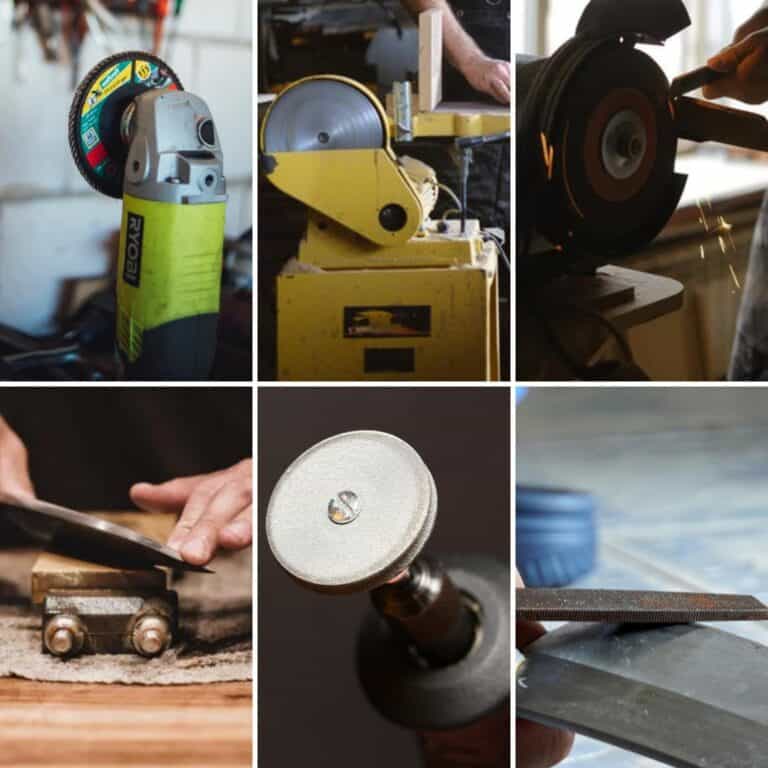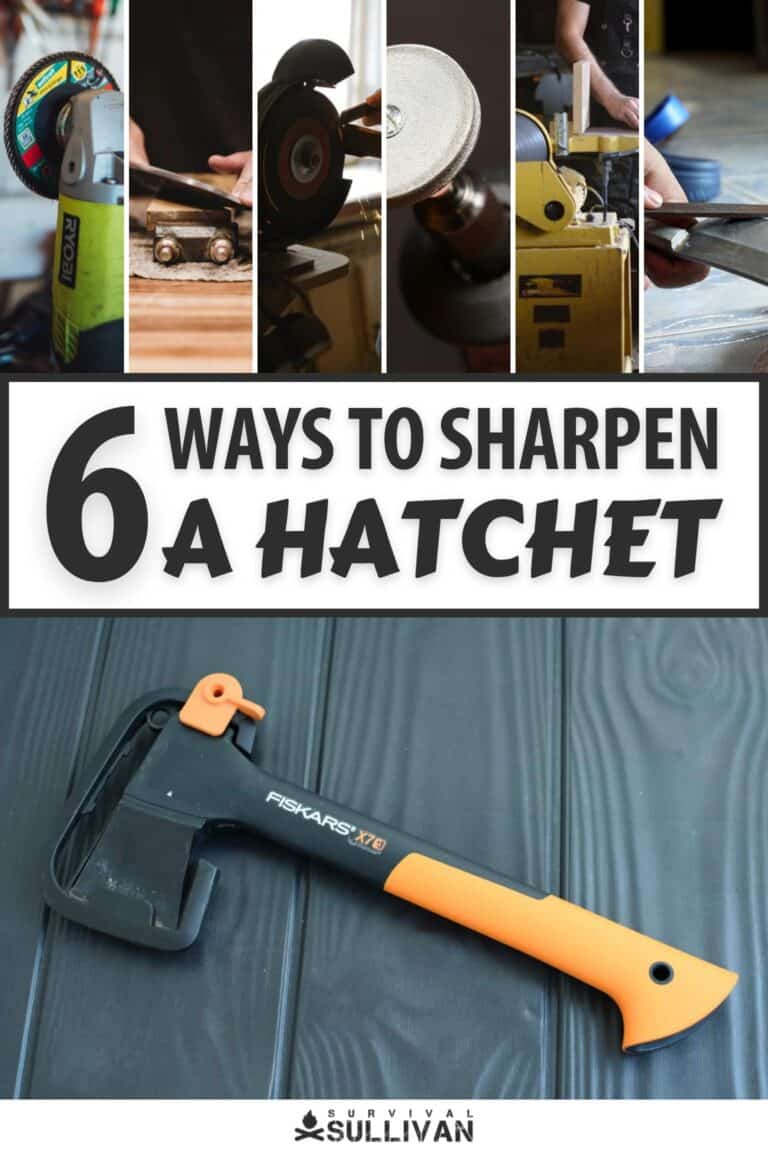The humble hatchet is one of the most compact, versatile and useful wood processing tools that any prepper could want.

They also make for a gnarly weapon in a close-quarters situation. When a full-sized axe is too much or you’re just trying to save as much weight as possible from your load a hatchet will fit the bill.
But any cutting tool is only as good as its cutting edge, and if you want to utilize your hatchet with maximum efficiency, not to mention safety, you’ll need to keep a proper working edge on it.
Though it is true that chopping tools like hatchets typically don’t need to be kept at razor sharpness like most knives if you neglect to maintain the edge you will only be working harder than you have to while simultaneously shortening the lifespan of your tool.
You’ll also be inviting accident, as a dull hatchet is far more likely to skip or glance off of the wood and then embed itself in your thigh or shin! That could put you into an entirely new category of survival situation.
You can prevent all of these unhappy outcomes by staying on top of regular maintenance, and foremost among that maintenance is sharpening.
In this article, we will provide you with six time-tested ways to sharpen your hatchet. You are sure to find one or two favorite methods that you can employ with your hatchet so you can keep on chopping. Keep reading to learn more.
A Note on Powered Sharpening
There are all kinds of ways to sharpen any edged tool, including hatchets, and among these methods are counted a variety of manual methods, where you perform the sharpening task by hand, and powered methods, where you employ some sort of power tool.
Both work, both have their advantages and disadvantages, and you should endeavor to learn and make use of both.
But concerning power sharpening in particular you’ll need to be on your guard and pay attention.
This is because the friction created by a power tool acting on your hatchet’s head will be intense, and will heat up the metal substantially.
It is an easy thing to zone out while you are working on getting the perfect bevel or edge established and unwittingly overheat the head, ruining the temper of the steel and making your hatchet even more susceptible to damage, or potentially even ruining it.
That would be the worst possible outcome of your endeavor!
The way to avoid this unfortunate outcome is to simply take your time when using a power tool, and stop regularly to cool down your workpiece using water or oil, making sure to do this well before it gets piping hot.
As long as you remember this simple advice you won’t have any issues regarding sharpening with a power tool. Now, let’s get on to the list!
6 Ways to Sharpen a Hatchet

1. Belt Sander
A belt sander is one of the quickest and most efficient ways to sharpen a hatchet using a power tool.
It also has a major advantage of being one of the most controllable, whether or not you are using a benchtop model or a handheld model with the hatchet clamped in a vise or to your work surface.
The wide, rotating belt allows you to work a more significant proportion of the hatchets edge and bevel at any given time, saving you time and establishing a uniform, crisp edge.
Take note, you should try to establish a rhythm either in a certain number of passes on each side or a certain amount of time in contact with the hatch its head.
Aim to replicate this on the opposite side so the edge is even and well established.
Also, don’t use too much pressure, take great care that you do not overheat the hatchet’s head and remember to cool it regularly: more than most other power tools the belt sander will impart a dramatic amount of heat, quickly! Take care to avoid this mishap and it will do a fine job.

2. Grinder
The grinder comes in many, varied forms, be it a benchtop grinding wheel or a handheld angle grinder.
This beefy, mighty tool is sort of your “nuclear option” when it comes to sharpening a hatchet, but for an old, abused or previously damaged tool it can be just the trick.
This is one tool that will easily eliminate nicks, dings and small bends in the blade, allowing you to establish a bevel very quickly and (with a steady hand) put a useable, if not good, edge on it.
Similar to the belt sander above you should make a certain number of back and forth passes to accomplish the work while paying careful attention to heat levels and then replicate that process on the opposite side of the edge periodically before coming back around, if required.
Also, ensure that the disc on your grinder is not too aggressive. Eating up a substantial amount of material off your hatchet’s head is only going to shorten its service life and give you nothing in the bargain.
This can also destroy hatchets that are differentially tempered! As always, correct disc or grit selection combined with a steady hand and some patience is the recipe for success with the grinder!
3. File
Filing is one of the most versatile, effective, and portable methods for sharpening a hatchet and using nothing more than a carefully chosen file you’ll be able to reshape and repair your hatchet.
For this task, you should choose a single- or double-cut flat mill bastard file, preferably one that has a more aggressive cut on the opposite side to afford you more flexibility.
You won’t even need to use a clamp or vice, although they are helpful, since you can just press the hatchet into a stump using your free hand or even hold it between your knees.
All you’ll need to do then is draw or push the file across the edge matching the angle with the bevel.
Anywhere from 6 to 20 strokes per side is usually adequate to restore the edge of a hatchet and reasonably good repair.
The best part about using a file for the task is that you won’t have to worry about substantial heat buildup like you would with a power tool.
Make sure you pause periodically to clean the “pins” (metal shavings) from the file’s teeth and don’t forget that files cut in one direction; don’t use a back and forth motion as this will only be hard on your file!

4. Rotary Tool or “Dremel”
Whether you are using an actual Dremel-brand rotary tool or something like a Proxon doesn’t matter.
What matters is that the rotary tool is often one of the handiest, most convenient power tools for sharpening all kinds of edged implements, hatchets included.
Being far cheaper, more available, and more forgiving of mistakes the rotary tool makes sense for most people.
The key to success with a rotary tool, when used for sharpening, is to really concentrate on what you were doing for establishing the correct angle to properly sharpen your hatchet.
These tools are light and nimble, and that makes them prone to shifting, tilting and skittering across your workpiece when you can least afford it!
Equally important is the choice of bit, or tip. Sanding wheels definitely work though you’ll have to use an extremely light touch as the blistering speed of rotary tools, even on low, combined with the small contact area makes it too easy to groove or notch your precious hatchet.
A better option is a dedicated set of aluminum oxide grinding stones, though you will still need to be cautious. Take your time, go slow and work the edge as evenly as you can. Remember that heat buildup will still be an issue.

5. Whetstone
Whetstones are most commonly employed to sharpen knives, but they work just as well on hatchets, with a few modifications.
The chief issue you will run into with whetstones is that you have to use an extremely coarse stone to remove a significant amount of metal from your hatchet’s edge.
For serious repairs, reprofiling, and the like you’ll need to use whetstones that are far more aggressive than the average “coarse” stone found in a sharpening kit.
Nonetheless, they do work and work well, and whetstones excel at putting a truly sharp edge on a preliminary edge you have established using some other method.
If you are sharpening your hatchet to be used as a defensive weapon you’ll definitely want to give it a going over with fine wet stones prior to declaring it good. But once you cut or chop something with a truly sharp hatchet, you’ll know.

6. Sharpening System
There are a variety of sharpening systems on the market today, from powered affairs like the excellent WorkSharp system, to the tried, true and greatly beloved Spyderco Tri-Angle Sharpmaker that can seemingly sharpen anything with an edge or point, and a lot of things that don’t!
Many of these systems can work to sharpen your hatchet either by design or with a little adaptation.
The key, as with any approach to sharpening, is to ensure you are getting the edge to contact the sharpener surface at the correct angle.
Sometimes easier said than done when working with something that is comparatively so large and bulky like a hatchet head.
It is easy to get sucked into chasing perfect alignment on one side and neglect the other, so don’t make that mistake.
Depending on your requirements, and your overall skill at sharpening, a sharpening system that ensures the correct angle is maintained could save you a considerable amount of time and effort when it comes to putting a working edge on your hatchet.
Conclusion
The hatchet is an ancient and time-honored tool that preppers still employ today, and with good reason. No other tool is this compact while also packing in as much capability.
But that capability will degrade steadily with use, and this necessitates sharpening. Everyone has their favorite method, and we have shared several of them with you in this article.
Make sure to view the linked videos and you’ll find a method that works for you in no time.

The post 6 Ways to Sharpen a Hatchet appeared first on Survival Sullivan.
By: Tom Marlowe
Title: 6 Ways to Sharpen a Hatchet
Sourced From: www.survivalsullivan.com/how-to-sharpen-a-hatchet/
Published Date: Wed, 03 Aug 2022 16:00:00 +0000
-------------------------------------------------------------------------
 CampingSurvivalistHuntingFishingExploringHikingPrivacy PolicyTerms And Conditions
CampingSurvivalistHuntingFishingExploringHikingPrivacy PolicyTerms And Conditions
